Abstract
Plants are reported to reconfigure their metabolism and generate secondary metabolites as a defence response towards herbivore attack. In this study we aimed to evaluate the anti-nutritive and defensive properties of phenolic compounds that were enhanced in Castor, Ricinus communis L. plant due to herbivore damage. Through HPLC studies it was observed that damage caused by two pests, Achaea janata L. and Spodoptera litura F. on the castor plant resulted in quantitative enhancement of syringic, coumaric, cinnamic and vanillic acids. These phenolic compounds showed considerable impact on insect’s feeding and their toxic nature towards the herbivores was determined by estimating three detoxification mid-gut enzymes, glutathione-s-transferase, carboxyl esterase and β-glucosidase. In the ovipositional and orientation bioassays with the egg parasitoid Trichogramma chilonis Ishii, syringic and coumaric acids had shown good kairomonal activity, thus defining a new role of these chemicals in indirect plant defence. Thus, this study demonstrates a quantitative association between plant phenolic accumulation and the elevated reproductive performance of the herbivore natural enemies, by illustrating the role of plant phenolics in both the direct and indirect induced plant defences.



Similar content being viewed by others
References
Akhtar Y, Isman MB (2004) Feeding responses of specialist herbivores to plant extracts and pure allelochemicals: effects of prolonged exposure. Entomol Exp Appl 111:201–208
Appel HM (1993) Phenolics in ecological interactions: the importance of oxidation. J Chem Ecol 19:1521–1552
Baldwin IT, Olson RK, Reiners WA (1983) Protein binding phenolics and the inhibition of nitrification in subalpine balsam fir soils. Soil Biol Biochem 15:419–423
Barbehenn RV (2002) Gut based anti-oxidant enzymes in a polyphagous and graminovorous grasshopper. J Chem Ecol 28:1329–1347
Berenbaum MR, Zangerl AR (1998) Chemical phenotype matching between a plant and its insect herbivore. Proc Natl Acad Sci USA 95:13743–13748
Bernays EA (1991) Relationship between deterrence and toxicity of plant secondary compounds for the grasshopper Schistocerca americana. J Chem Ecol 17:2519–2526
Bulla AU, Suarez MM, Moreno-Murillo B (2004) Biological activity of phenolic compounds from Alchornea glandulosa. Fitoterapia 75:392–394
Carter M, Sachdev-Gupta K, Feeny P (1998) Tyramine from the leaves of wild parsnip: a stimulant and synergist for oviposition by the black swallowtail butterfly. Physiol Entomol 2:303–312
Che-Mendoza A, Patricia Penilla P, Américo Rodríguez D (2009) Insecticide resistance and glutathione S-transferases in mosquitoes: a review. Afr J Biotech 8:1386–1397
Chen L, Fadamiro HY (2007) Differential electroantennogram response of females and males of two parasitoid species to host-related green leaf volatiles and inducible compounds. Bull Entomol Res 97:515–522
Diaz Napal GN, Defagó MT, Valladares GR, Palacios SM (2010) Response of Epilachna paenulata to two flavonoids, pinocembrin and quercetin, in a comparative study. J Chem Ecol 36:898–904
Govindappa T, Govardhan L, Jyothy PS, Veerabhadrappa PS (1987) Purification and characterisation of a carboxylesterase from the latex of Synadenium grantii hook, ‘f’. J Biosci 12:71–86
Grant GG, Langevin D (2002) Structure-activity relationships of phenolic and nonphenolic aromatic acids as oviposition stimuli for the spruce budworm, Choristoneura fumiferana (Lepidoptera: Tortricidae). IOBC WPRS Bull 25:307–314
Hagg JF, Zagrobelny M, Bak S (2013) Plant defense against insect herbivores. Int J Mol Sci 14:10242–10297
Isman MB, Duffey SS (1982) Toxicity of tomato phenolic compounds to the fruitworm, Heliothis zea. Entomol Exp Appl 31:370–376
Jyothsna Y, Mathur K, Usha Rani P (2009) Effects of herbivore feeding on biochemical and nutrient profile of castor bean, Ricinus communis L. plants. Allelopathy J 24:131–142
Korkina LG (2007) Phenylpropanoids as naturally occurring antioxidants: from plant defense to human health. Cell Mol Biol 53:15–25
Lewis AC, van Emden HF (1986) Assays for insect feeding. In: Miller JR, Miller TA (eds) Insect–plant interactions. Springer, New York, USA, pp 95–119
Lin LZ, Mukhopadhyay S, Robbins RJ, Harnly JM (2007) Identification and quantification of flavonoids of Mexican oregano (Lippia graveolens) by LC-DAD-ESI/MS analysis. J Food Compos Anal 20:361–369
Low NH, Vong KV, Sporns P (1986) A new enzyme, β-glucosidase, in honey. J Apic Res 25:178–181
Mazid M, Khan TA, Mohammad F (2011) Role of secondary metabolites in defense mechanisms of plants. Biol Med 3:232–249
Mukherjee S (2003) Influence of plant allelochemicals on growth rate, nutritional physiology and mid-gut esterase activity in fifth instar larvae of Spodoptera litura (F.) (Lepidoptera: Noctuidae). Invertebr Reprod Dev 43:125–132
Nishida R (1995) Oviposition stimulants of swallowtail butterflies. In: Scriber JM, Tsubaki Y, Lederhouse RC (eds) Swallowtail butterflies: their ecology and evolutionary biology. Scientific Publishers, Gainesville, USA, pp 17–26
Pare PW, Tumlinson JH (1999) Plant volatiles as a defense against insect herbivores. Plant Physiol 121:325–331
Perveen SS, Qaisrani TM, Bhutta S, Perveen R, Naqvi SHM (2001) HPLC analysis of cotton phenols and their contribution in bollworm resistance. Online J Biol Sci 1:587–590
Roininen H, Price PW, Julkunen-Tiitto R, Tahvanainen J, Ikonen A (1999) Oviposition stimulant for a gall-inducing sawfly, Euura lasiolepis, on willow is a phenolic glucoside. J Chem Ecol 25:943–953
Simmonds MSJ, Stevenson PC (2001) Effects of isoflavonoids from Cicer on larvae of Helicoverpa. J Chem Ecol 27:965–977
Singleton VL, Rossi JA (1965) Colorimetry of total phenolics with phosphomolybdic-phosphotungstic acid reagents. Am J Enol Vitic 16:144–158
Sintim HO, Tashiro T, Motoyama N (2009) Response of the cutworm Spodoptera litura to sesame leaves or crude extracts in diet. J Insect Sci 9:1–13
Summers CB, Felton GW (1994) Prooxidant effects of phenolic acids on the generalist herbivore Helicoverpa zea (Lepidoptera: Noctuidae): Potential mode of action for phenolic compounds in plant anti-herbivore chemistry. Insect Biochem Mol Biol 24:943–953
Tammaru T, Javois J (2000) Responses of ovipositing moths (Lepidoptera: Geometridae) to host plant deprivation: life-history aspects and implications for population dynamics. Environ Entomol 29:1002–1010
Tuzen M (2003) Chromatographic determination of phenolic acids in the snowdrop by HPLC. Turk J Chem 27:49–54
Usha Rani P, Jyothsna Y (2010) Biochemical and enzymatic changes in rice plants as a mechanism of defense. Acta Physiol Plant 32:695–701
Usha Rani P, Pratyusha S (2013) Defensive role of Gossypium hirsutum L. anti-oxidative enzymes and phenolic acids in response to Spodoptera litura F. feeding. J Asia Pac Entomol 16:131–136
Usha Rani P, Ravibabu MV (2011) Allelochemicals in castor (Ricinus communis) plants and their impact on pest larval feeding as anti-herbivore defensive. Allelopathy J 27:263–276
Usha Rani P, Sandhyarani K (2012) Specificity of systemically released rice stem volatiles on egg parasitoid, Trichogramma japonicum Ashmead behavior. J Appl Entomol 136:749–760
Usha Rani P, Jyothsna Y, Lakshminarayana M (2008) Host and non-host plant volatiles on oviposition and orientation behaviour of Trichogramma chilonis Ishii. J Biopest 1:62–68
Vimala DPS, Rao MLN (2005) Tailoring production technology: Bacillus thuringiensis (Bt) for localized production. Tailoring Biotech 1:107–120
Wrubel RP, Bernays EA (1990) Effects of ingestion of some non-host plant secondary compounds on larvae of Manduca sexta. Entomol Exp Appl 54:125–130
Xavier LMS, Laumann RA, Borges M, Magalhães DM, Vilela EF, Blassioli-Moraes MC (2011) Trichogramma pretiosum attraction due to the Elasmopalpus lignosellus damage in maize. Pesq Agropec Bras 46:578–585
Acknowledgments
Authors are grateful to Dr. Lakshmikantham, Director, CSIR-Indian Institute of Chemical Technology) for the facilities.
Author information
Authors and Affiliations
Corresponding author
Additional information
Handling Editor: Torsten Meiners
Rights and permissions
About this article
Cite this article
Usha Rani, P., Pratyusha, S. Role of castor plant phenolics on performance of its two herbivores and their impact on egg parasitoid behaviour. BioControl 59, 513–524 (2014). https://doi.org/10.1007/s10526-014-9590-y
Received:
Accepted:
Published:
Issue Date:
DOI: https://doi.org/10.1007/s10526-014-9590-y




